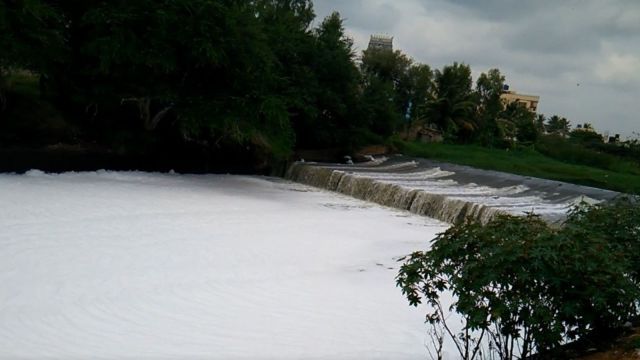Karnataka okays an extra Rs 79 crore for rejuvenation of Bengaluru’s polluted Bellandur lake
The comprehensive development of Bellandur Lake has been taken up on National Green Tribunal directions; Law Minister H K Patil said the total allotment has gone up to Rs 179 crore.
 Indian Institute of Science (IISc), Bengaluru, had cited the entry of sewage into the Bellandur Lake as one of the major causes of pollution of the water body.
(Express Photo)
Indian Institute of Science (IISc), Bengaluru, had cited the entry of sewage into the Bellandur Lake as one of the major causes of pollution of the water body.
(Express Photo)The Karnataka government has cleared an additional Rs 79 crore allotment for the rejuvenation of Bellandur lake in East Bengaluru, which has been choked by pollution in recent years, resulting in the foaming of the lake at many locations.
The Cabinet of the Congress government on Friday cleared the allocation of the enhanced amount, taking the total allotment for the lake rejuvenation project from Rs 100 crore to Rs 179 crore, Law Minister H K Patil said after the meeting.
The comprehensive development of the Bellandur Lake has been taken up on the directions of the National Green Tribunal, with Bengaluru Development Authority bearing 25 per cent of the cost and the state government 75 per cent.
“The National Green Tribunal had suggested that if additional funds are required for the comprehensive development of Bellandur Lake, a separate proposal should be submitted to the government. A proposal was presented to the Cabinet that there is a need to provide an additional grant of Rs 79.67 crore for the rehabilitation and development work,” the Cabinet meeting was informed on Friday.
In 2023, a study by the Centre for Sustainable Technologies (CST) at the Indian Institute of Science (IISc), Bengaluru, had cited the entry of sewage into the Bellandur Lake as one of the major causes of pollution of the water body.
“The first reason is untreated sewage that enters the lake. Since the lake is large, the sewage takes 10-15 days to disperse through the lake; during this time, a part of the organic material gets degraded in the absence of oxygen and settles down as sludge. As more and more sewage flows through the lake, surfactants in the sewage do not decompose and instead get loosely attached to the settled sludge, gradually increasing in concentration,” CST chief research scientist H N Chanakya had reported in 2023.
Surfactants reduce the surface tension of water.
The major source of surfactants is cleaning detergents, shampoos, and soaps.
The analysis by the CST team suggested that a single type of surfactant commonly used in most household washing powders and shampoos plays a dominant role in driving this foaming.
One of the reasons the foaming of the Bellandur Lake has puzzled researchers is the fact that the foaming increases only after heavy rain, although the increase in water in the lake is supposed to dilute pollutants in the lake.
A second factor highlighted in the study was that during heavy rainfall, the “high-volume inflow appears to churn up the surfactant-laden sludge, dislodge the accumulated surfactant from the sludge, and bring it back into solution, making it ready to foam.”
“Deep inside the lake itself, there is little foam, because air bubbles do not form. However, as the water level in the lake rises due to rains, the excess water containing large concentrations of the surfactants spills over into the lake’s outlet to depths as high as 25 feet, trapping air bubbles which turn into foam. This is an important phenomenon that converts the surfactant-laden water into foam,” CST scientists said in 2023.
The study proposed the stopping of the entry of untreated sewage into the lake as a crucial step to prevent the build-up of surfactants and sludge.
They also suggested that wherever this is not possible, removing the accumulated sludge in the polluted lake, at least before the rain, as well as proper disposal of it can address the issue.







